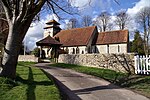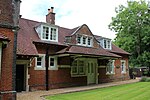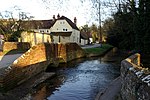Droxford railway station was an intermediate station on the Meon Valley Railway, built to a design by T. P. Figgis and opened in 1903. It served the villages of Droxford, Soberton and Hambledon in Hampshire, England. The railway served a relatively lightly populated area, but was built to main line specifications in anticipation of it becoming a major route to Gosport. Consequently, although the station was built in an area with only five houses, it was designed with the capacity to handle 10-carriage trains. It initially proved successful both for the transport of goods and passengers, but services were reduced during the First World War and the subsequent recession, and the route suffered owing to competition from road transport.
In 1944, amid World War II, Droxford station was used by the Prime Minister Winston Churchill as his base during preparations for the Normandy landings. Based in an armoured train parked in the sidings at Droxford, Churchill met with numerous ministers, military commanders and leaders of allied nations. On 4 June 1944, shortly before the landings were due to take place, Free French leader Charles de Gaulle visited Churchill at Droxford, and was informed of the invasion plans. When discussing the future governance of liberated France at this meeting, Churchill expressed his view that if forced to side with France or the United States he would always choose the United States, a remark which instilled in de Gaulle a suspicion of British intentions and caused long-term damage to the postwar relationship between France and Britain.
After the war, with Britain's railway network in decline, services on the Meon Valley Railway were cut drastically. A section of the line north of Droxford was closed, reducing Droxford to being the terminus of a short 9+3⁄4-mile (15.7 km) branch line. In early 1955 the station closed to passengers, and in 1962 it closed to goods traffic. Following its closure, Droxford station and a section of its railway track were used for demonstrating an experimental railbus until the mid-1970s. It then briefly served as a driving school for HGV drivers, before becoming a private residence and being restored to its original appearance.









